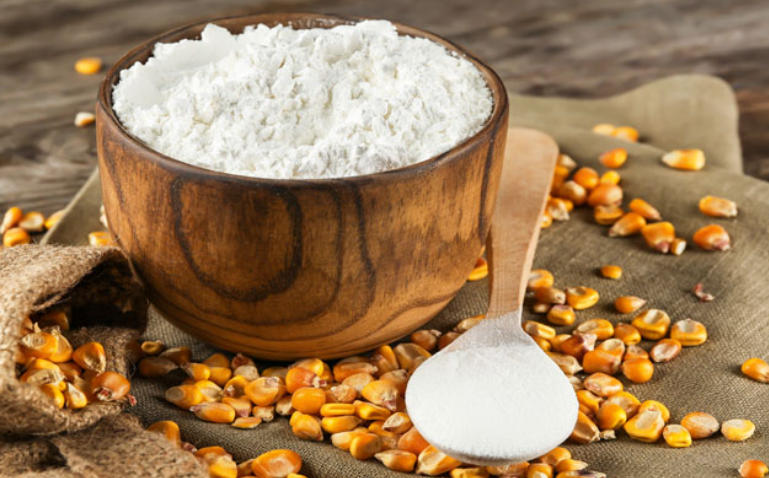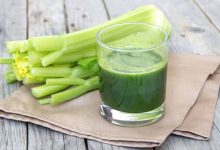Corn starch properties
1. Hypoglycemia (low blood sugar) prevention
Raw corn starch may prevent hypoglycemia, according to some studies. This food acts as a glucose reservoir in the digestive tract and is slowly absorbed by the digestive system within 6 to 8 hours. Therefore, people with type 1 and type 2 diabetes do not experience hypoglycemia.
2. It is easier to swallow
When swallowing solid or liquid food is difficult for people with dysphagia, corn starch can help. Using this starch is also a good solution to solve swallowing problems with increasing age. By softening the bolus (a mixture formed from food and saliva after chewing), this food item aids in swallowing.
3. A good substitute for corn syrup
Some processed foods and even homemade foods are thickened with corn syrup. A high consumption of corn syrup or corn syrup rich in fructose has been linked to diseases such as type 2 diabetes, metabolic syndrome, and fatty liver. These risks can be reduced by using corn starch.
4. Foods that are gluten-free
In place of wheat flour, corn starch can be used by those allergic to wheat and gluten, suffering from celiac disease, or following a gluten-free diet for any other reason.
5. Weight Loss
A low glycemic index of corn starch reduces appetite and creates a feeling of satiety, according to researchers. Furthermore, this starch adds fewer calories to the body and can assist in weight loss.
Drinks containing this substance, which is rich in amylose or glucose, reduce appetites while adding calories to the body. In addition, they expose people to type 2 diabetes.

Effects of corn starch
1. allergy
It is not recommended to consume this food item if you are allergic to it. Mild to severe allergic reactions to corn starch include:
Vomit;
stomach problems;
wheezing or difficulty breathing;
weak pulse;
Skin changes including hives;
swelling of the lips or tongue;
dizziness
Anaphylaxis can even occur in severe cases. An allergic attack occurs suddenly and may result in death.
2. Heart disease risk
Refined carbs, such as cornstarch, have been highly processed and stripped of their nutrients. Carbohydrate-rich foods negatively affect the heart, according to research. Consuming carbohydrates can also increase blood pressure, so be careful.
Nutritional value of corn starch and how to prepare it
The starchy endosperm of corn is pulverized to make this food item. While this starch does not have significant nutritional value, it has many uses in food preparation.
carbohydrate
Corn starch contains about 30 calories per 8 grams, which come from carbohydrates. Raw corn has a low glycemic index despite having a lot of starch. Studies have shown that this type of starch is slowly absorbed by the body.
Fat and protein
8 grams of corn starch contain no fat, protein, or special minerals, and 1 cup contains less than 1 gram of fat and only about 0.3 grams of protein. Furthermore, this food does not contain any special minerals or vitamins.
There is a difference between corn flour and corn starch
In terms of nutritional value, taste, and use, corn flour and its starch are both derived from corn.
During the process of making corn flour, whole corn kernels are powdered and completely softened before being processed into flour. Soft starch powder is made from the starchy part of corn.
Corn flour contains protein, fiber, starch, vitamins and minerals found in whole and yellow corn. Despite this, its starch lacks the fiber and protein found in corn’s whole grain. White starch is formed when starch is processed.
The taste of these 2 corn products is also different. Starch in cornmeal is almost tasteless, but cornmeal has a sweet taste like corn.

Corn starch is used in many applications
The common misconception is that this material is only used for cooking, but it has diverse uses, some of which we will explain below.
1. Skin care with corn starch
Irritated skin can be treated with cornstarch, which is an inexpensive yet effective treatment. Sunburn and itching of the skin can be treated with this starch. Mix the starch with cold water and apply the paste to the injured areas.
2. The use of corn starch in hair
This starch powder can be used as a dry shampoo. Sprinkle a small amount of starch on the roots of your hair and comb the powder slowly and gently to the bottom. The trick won’t work if your hair is dark, since corn starch is colored and shows up on the sides.
Furthermore, if your hair gets tangled, you can use cornstarch to detangle it because it reduces friction and makes hair strands slippery, so you can easily untangle it.
3. Making a kind of deodorant
To reduce sweat and body odor, corn starch can be used as a natural deodorant. Prepare the following ingredients to make natural deodorant:
Coconut oil in three tablespoons;
Starch, 2 tablespoons;
Baking soda, 2 tablespoons.
Melt the coconut oil in the microwave for 15 to 20 seconds. Mix cornstarch and baking soda slowly until you get a thick paste. You can certainly add your favorite essential oil to this mixture. It’s so easy to make your own natural deodorant! People who are allergic to baking soda or who sweat excessively should not use this deodorant.
4. Matte nail polish color
If you want to make your nail polish matte, just add some cornstarch to it and after mixing them thoroughly, apply the polish to your nails. In this way, the color of your nail polish will be matte.
5. The prevention of athlete’s foot
Athlete’s foot occurs when the foot is constantly exposed to moisture, such as sweat. By keeping the feet dry, this food item prevents this disease.
To prevent your feet from getting wet, sprinkle cornstarch inside your shoes or socks if you have to wear them for a long time.
6. Getting rid of body sweat
Body sweating can also be solved with corn starch. To prevent friction between fatty surfaces of the body, this starch can be used. Apply a little starch powder to these parts of your body before wearing clothes to prevent sweating. Diaper-wearing babies can also use this starch to prevent sweating.
7. Insect bite treatment
Itchy and painful insect bites are made worse by wet skin. To relieve itchy skin, mix 2 tablespoons of corn starch with a few drops of cold water and place it on the bite area.
8. Relief from blisters
Blisters on the skin get worse in moist environments or when they touch surfaces such as shoes or clothing. To reduce friction and keep the blister dry, apply some starch to the area. Do not apply starch to open blisters or sores on your skin, as this can cause infection.
Other uses
Use this material to untie knots in thread, shoelaces, and ropes.
This type of starch can be used to brighten silverware.
Increase friction: If your hands sweat a lot and you struggle during sports like tennis, put some starch powder on your palms.
Using corn starch, you can easily remove grease stains. After 10 to 15 minutes, spray it on the stain and wipe it off. Fat stain disappears. With this type of starch, you can also lighten the carpet. Sprinkle some starch powder on the carpet and vacuum it half an hour later. Almost all of the carpet’s darkness is removed.
Corn starch and corn flour are used to make food
The taste and composition of corn flour and starch flour differ, so they cannot be used interchangeably.
Bread, pancakes, waffles, biscuits, and all kinds of sweets can be baked with corn flour instead of wheat flour. These foods have a corn flavor and a yellow color due to corn flour.
More than adding flavor, this starch changes the texture and thickens the food. Soups, stews, sauces, and broths are thickened with it. Corn starch can also be used to improve the consistency of cakes and cutlets.
When adding starch to hot food, first dissolve it in a separate container with cold water before adding it to the hot food.
Method of maintenance
You should keep cornstarch away from moisture since it absorbs moisture. It is recommended to store this type of starch in a dry, cool environment. It will last a lifetime if you maintain it properly.


